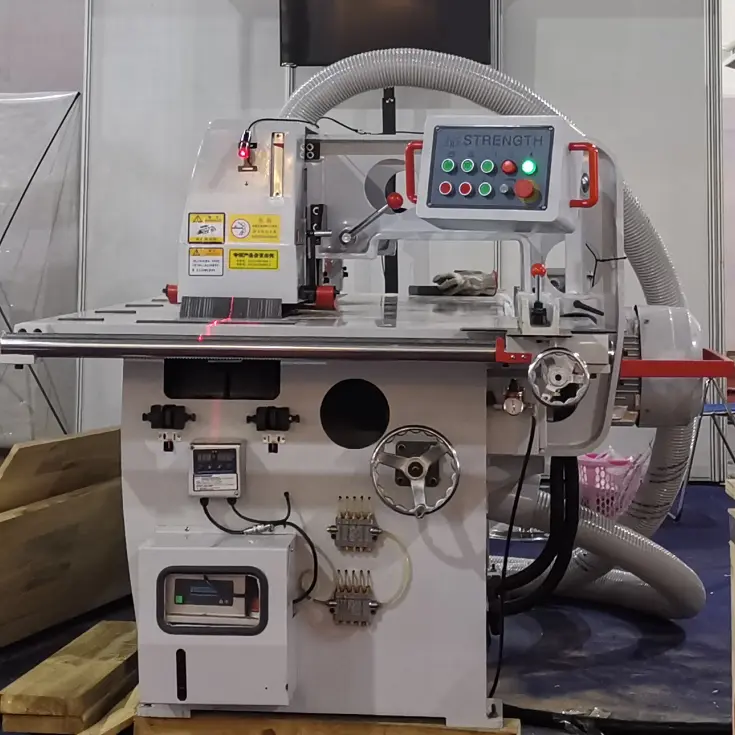Automatic single blade saws with bottom spindle are essential machines in the woodworking industry, designed to efficiently and accurately saw wooden boards to the required width. There are several key factors to consider when choosing the right automatic single blade saw with a bottom spindle for your woodworking job. From a machine’s specifications to its features and capabilities, making informed decisions is crucial to ensuring optimal performance and productivity. In this article, we will look at the important aspects to consider when choosing an automatic single blade saw with a bottom spindle.
Cutting ability:
The cutting capabilities of an automatic single blade saw is a key factor to consider. It determines the maximum width and thickness of boards that the machine can handle. When choosing a saw, it is important to evaluate your specific production needs and select a machine with the cutting capabilities that meet your requirements. Whether you’re working with standard-sized boards or larger custom sizes, making sure the saw can accommodate your materials is critical to a seamless operation.
Power and speed:
The power and speed of an automatic single blade saw play an important role in its performance. The higher power allows the machine to handle hardwood and thicker materials with ease, while the speed helps improve the overall efficiency of the cutting process. It’s important to evaluate your saw’s motor power and cutting speed to ensure it can meet the needs of your production environment. Additionally, consider variable speed options for flexibility in handling different types of wood and cutting requirements.
Precision and accuracy:
Woodworking operations require precision and accuracy, and automatic single blade saws should provide consistent results. Look for features like digital readouts, laser guides, and adjustable fences to help increase machine accuracy. In addition, the stability and rigidity of the saw structure play a vital role in maintaining precision during cutting. Ensuring that the saw is equipped with features that support precise cutting will ultimately impact the quality of the final product.
Safety features:
Safety is paramount in any woodworking environment and automatic single blade saws should be equipped with the necessary safety features to protect the operator and minimize the risk of accidents. Features such as blade guards, emergency stop buttons and anti-kickback devices are critical to safe operation. Prioritizing safety when selecting a saw not only protects the operator, but also helps create a safer, more compliant work environment.
Automation and control:
The level of automation and control capabilities provided by automatic single blade saws can significantly impact productivity and ease of operation. Look for features like programmable settings, digital controls, and automatic adjustments to streamline the cutting process and reduce the need for manual intervention. The advanced control system also helps optimize material yield and minimize waste, making the saw a valuable asset in the production workflow.
Maintenance and Serviceability:
Choosing a saw that is easy to maintain and repair can help improve its long-term reliability and performance. Consider factors such as accessibility for blade replacement, lubrication points and overall maintenance requirements. Additionally, assessing the availability of technical support and access to spare parts is important to ensure that the saw is effectively repaired and maintained throughout its service life.
Reputation and Support:
When investing in an automatic single blade saw with a bottom spindle, it is crucial to consider the manufacturer’s reputation and available customer support. Research the manufacturer’s track record, customer reviews, and availability of technical support and training. A reputable manufacturer with a strong support network can provide confidence in the reliability and performance of the saw and ensure that help is available when needed.
In summary, choosing the right automatic single-blade saw with bottom spindle requires a comprehensive evaluation of its cutting capabilities, power, precision, safety features, automation, maintenance and the manufacturer’s reputation. By carefully evaluating these factors and combining them with your specific production requirements, you can choose a saw that not only meets your current needs, but also helps improve the efficiency and quality of your woodworking operations. Investing in a high-quality automatic single blade saw with a bottom spindle is an investment in the productivity and success of your woodworking business.
Post time: Jun-07-2024

